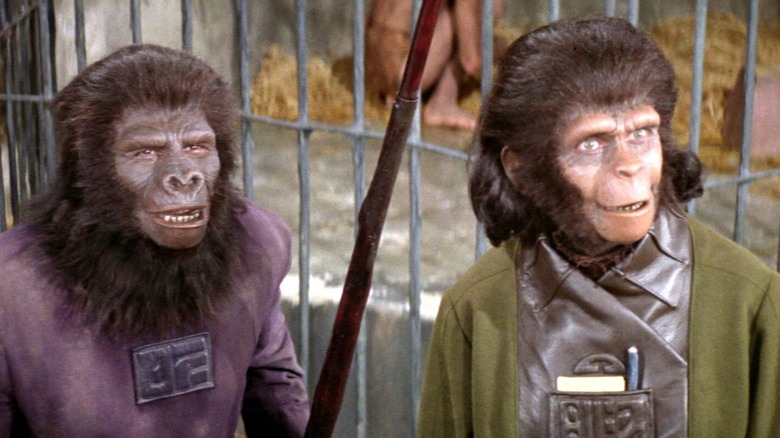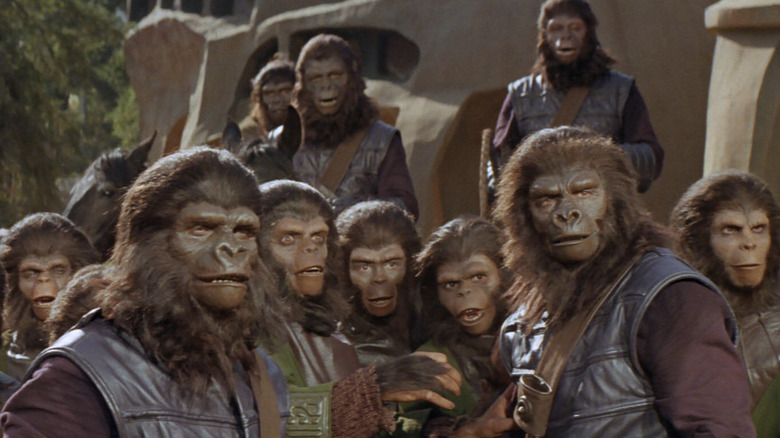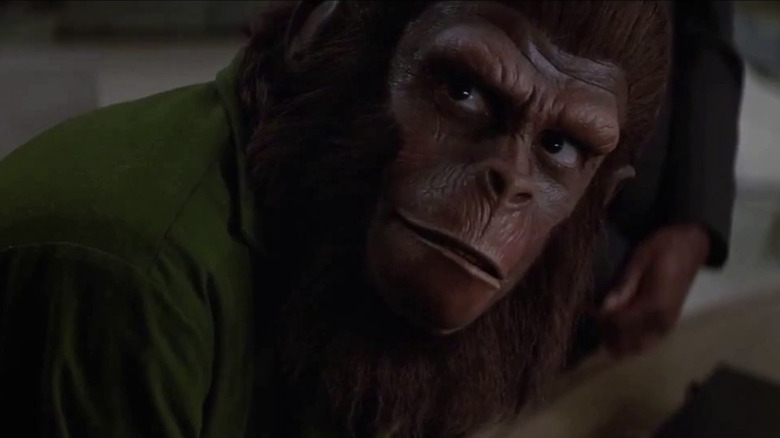Why Planet Of The Apes' Security Was Unusually Tight On Set
"The Planet of the Apes" was not a style-over-substance type of science-fiction film, but the effectiveness of the story still lived and died on its special effects. If a title promises an otherworldly planet of inhabitants, it better deliver and showcase some damn, convincing apes. Fortunately, the film's make-up artists, chief among them the late John Chambers, delivered. Their efforts are the reason "Planet of the Apes" endures as a franchise to this day, and the make-up design process was eventually the subject of a 2019 documentary, "Making Apes: The Artists Who Changed Film."
While audiences knew what they were getting into, the film still presents the apes as a surprise. They don't show up until the end of the first act and there's a dramatic close-up of the first gorilla on horseback. Ensuring the public went into the movie without any visual spoilers meant there was extra tight security during the production.
Keeping makeup under wraps
The ape makeup looked great, but it was cumbersome on the actors. For one, it limited their ability to eat. According to Kim Hunter (who played Zira) and Roddy McDowall (who played Cornelius), they had to eat in front of mirrors to avoid damaging their make-up. It was vital they did not disturb the makeup since it took 3 and a half hours to apply. As McDowall documented, the ape actors would take their breaks and lounge around on set while still in full make-up.
Since the ape actors would be in make-up all day, it would be easy to snap photographs of them. That meant security had to be extra strict. Army Archerd of Variety spoke with producer Arthur P. Jacobs, who explained the need for secrecy. Archerd summed up the situation as:
"The unusual ape makeup [is] worn by most of the 235 actors in [the] pic. The studio is not permitting any stills to be published until pic's release next Easter and is also guarding sketches and photographs of the simian city, which the art department created over two years."
Why the need for secrecy?
So, why did the film's producers and crew feel such a need for secrecy? Army Archerd cited two reasons in his Variety reporting. One, Arthur P. Jacobs and co. wanted to maintain the "surprise element" for the audience. Two, there was concern that if stills of the film's production were publicly available then other studios might try to ape the designs. 20th Century Fox wasn't about to let someone else corner the monkey movie market before their $5 million investment had even hit theaters.
There's another possible explanation if you read between the lines. According to Variety, a hurdle the film faced when in development was that some thought "an ape-human switcheroo" was too silly a premise to render on film. This concern might be another reason for on-set secrecy — if potential audiences caught sight of the makeup and rejected it, that would doom the film.
In any case, the fears that audiences would laugh turned out unfounded. "Planet of the Apes" was an all-around success and spawned a franchise. From 1970 to 1973, there was an "Apes" movie every year. Even so, the makeup did its job so well that it never evolved. When Roddy McDowall played Caesar in "Conquest of the Planet of the Apes," he looked identical to how he appeared as Cornelius in the first film. If audiences had laughed at how the made-up McDowall had looked, that wouldn't have been the case.


